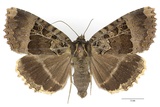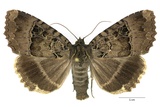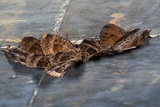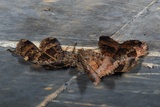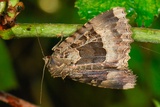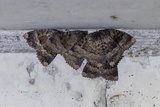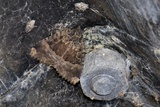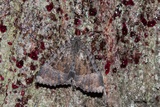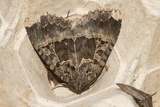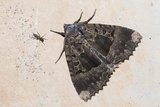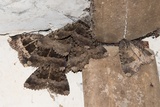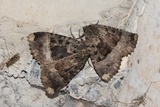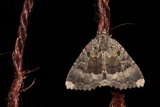Mormo maura (Linnaeus, 1758) Species
Last modified: Nov. 18, 2025, 6:20 p.m.
Used to be rare and local and mainly observed species in the south of the country, but since about 2010 more and more observations became known from Flanders and the coastal area.
Nowadays (2020) a fairly common species throughout Belgium, more observations in the north.
This species is considered Least Concern according to the IUCN Red List category for Flanders 2023.
Details
- Classification
- Family: Noctuidae > Subfamily: Xyleninae > Tribus: Dypterygiini > Genus: Mormo > Species: Mormo maura
- Vernacular names
- Zwart weeskind (NL), Old Lady (EN), La Maure (FR), Schwarzes Ordensband (DE)
- First mention in Belgium
- De Sélys-Longchamps E. 1844. Énumération des insectes Lépidoptères de la Belgique. — Mémoires de la Société royale des Sciences de Liége 2: 1–35. On page 10 (as Mania maura L.). view page
- Status
-
Native
Distribution
Bionomics
Hibernates as a small larva, low down in the vegetation.
They pupate in a cocoon behind bark, among Ivy, in crevices and in loose earth.
The adults rarely come to light but often to sugar. They hide gregariously in dark and wet places during daytime.
Flight periods
The adults fly in one generation a year from mid-June till late October. Most observations are in August and September.
Observed on
- Host plant (species):
- Euonymus europaeus and Stellaria media
- Host plant (genera):
- Prunus, Crataegus, Betula, Salix, Ulmus, Lamium, Rumex and Hedera
- Substrates:
- Deciduous trees, Herbaceous plants, Polyphagous and Shrubs
In autum, the larva lives on a variety of herbaceous plants like Rumex, Lamium or Stellaria media. In spring, mainly on shrubs and trees like Hedera, Euonymus, Crataegus, Betula or Prunus spinosa.
